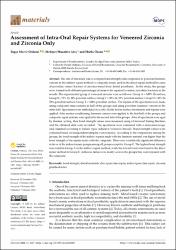| dc.contributor.author | Ordueri, Tuğçe Merve | |
| dc.contributor.author | Ateş, Mehmet Muzaffer | |
| dc.contributor.author | Özcan, Mutlu | |
| dc.date.accessioned | 2023-03-24T08:10:56Z | |
| dc.date.available | 2023-03-24T08:10:56Z | |
| dc.date.issued | 2023 | en_US |
| dc.identifier.citation | Ordueri, T. M., Ateş, M. M. ve Özcan, M. (2023). Assessment of intra-oral repair systems for veneered zirconia and zirconia only. Materials, 16(4). https://dx.doi.org/10.3390/ma16041407 | en_US |
| dc.identifier.issn | 1996-1944 | |
| dc.identifier.uri | https://dx.doi.org/10.3390/ma16041407 | |
| dc.identifier.uri | https://hdl.handle.net/20.500.12511/10687 | |
| dc.description.abstract | The aim of this study was to compare bond strength resin composites to porcelain laminate veneers in the indirect repair method to composite resins used in the direct repair method for cases of porcelain veneer fracture of zirconia-based fixed dental prostheses. In the study, the groups were formed with different percentages of areas to be repaired to mimic porcelain fractures in the mouth. The experimental group of veneered zirconia were as follows: Group A = 100% Zr surface; Group B = 70% Zr, 30% porcelain surface; Group C = 50% Zr, 50% porcelain surface; Group D = 30% Zr, 70% porcelain surface; Group E = 100% porcelain surface. The repairs of the specimens were made using composite resin systems in half of the groups and using porcelain laminate veneers in the other half. Specimens were embedded in acrylic blocks before surface treatments and repairs were applied. After surface conditioning, laminate veneers were applied to the first half of the groups, and composite repair systems were applied to the second half of the groups. After all specimens were aged by thermal cycling, their bond strength values were measured using a Universal Testing Machine, and the obtained data were recorded. The specimens were examined with a stereomicroscope and classified according to failure types (adhesive/cohesive/mixed). Bond strength values were evaluated based on independent-samples t-test statistics. According to the comparisons among the groups, the bond strength of the indirect repairs made with the laminate material was higher than the bond strength of the repairs made with the composite. There was a statistically significant difference in favor of the indirect repair groups among all groups except for Group C. The highest bond strength was found in Group A in the indirect repair method, while the lowest bond was found in the direct repair method in Group E. Adhesive failure was mostly seen in the groups that were repaired with the composite. | en_US |
| dc.language.iso | eng | en_US |
| dc.publisher | MDPI | en_US |
| dc.rights | info:eu-repo/semantics/openAccess | en_US |
| dc.rights.uri | https://creativecommons.org/licenses/by/4.0/ | * |
| dc.subject | Bond Strength | en_US |
| dc.subject | Dental Materials | en_US |
| dc.subject | Direct Porcelain Repair | en_US |
| dc.subject | Indirect Porcelain Repair | en_US |
| dc.subject | Zirconia | en_US |
| dc.subject | Prosthodontics | en_US |
| dc.title | Assessment of intra-oral repair systems for veneered zirconia and zirconia only | en_US |
| dc.type | article | en_US |
| dc.relation.ispartof | Materials | en_US |
| dc.department | İstanbul Medipol Üniversitesi, Diş Hekimliği Fakültesi, Protetik Diş Tedavisi Ana Bilim Dalı | en_US |
| dc.authorid | 0000-0002-7238-9102 | en_US |
| dc.authorid | Attribution 4.0 International | * |
| dc.identifier.volume | 16 | en_US |
| dc.identifier.issue | 4 | en_US |
| dc.relation.publicationcategory | Makale - Uluslararası Hakemli Dergi - Kurum Öğretim Elemanı | en_US |
| dc.identifier.doi | 10.3390/ma16041407 | en_US |
| dc.institutionauthor | Ordueri, Tuğçe Merve | |
| dc.institutionauthor | Ateş, Mehmet Muzaffer | |
| dc.identifier.wosquality | Q1 | en_US |
| dc.identifier.wos | 000940653700001 | en_US |
| dc.identifier.scopus | 2-s2.0-85149166659 | en_US |
| dc.identifier.pmid | 36837036 | en_US |
| dc.identifier.scopusquality | Q2 | en_US |



















